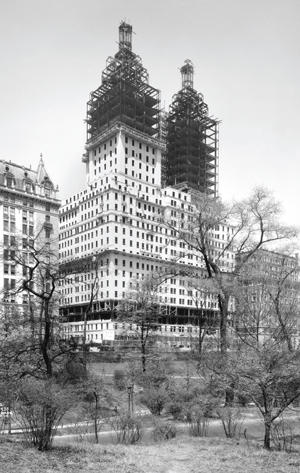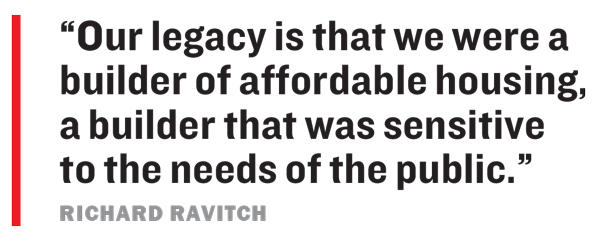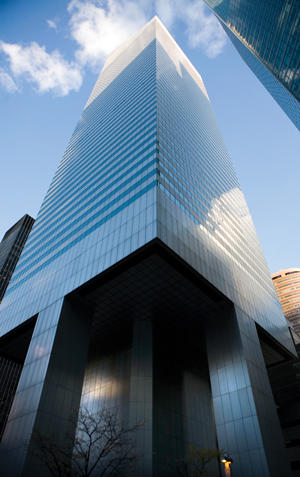In its final years, a dark cloud has hung over HRH Construction Corporation.
Accused of engaging in an overbilling scheme during the development of 2 Broadway, a Manhattan office tower, the firm was forced to pay back millions of dollars in 2007. It filed for bankruptcy two years later.
And in 2011, unions sued HRH for allegedly using nonunion dummy companies to cheat workers out of millions of dollars in wages. That suit was tied to several high-end projects, including Lalezarian Properties’ luxury rental buildings at 350 West 37th Street and 257 Gold Street in Brooklyn. Creditors are still picking over HRH’s remains, lawyers say.
Yet the 93-year-old firm was once a very bright light in New York City’s development scene, with work that ranged from Uptown co-ops like the San Remo to massive publicly subsidized housing complexes like Waterside Plaza.
The man who led HRH to such prominence was Saul C. Ravitch, who founded the firm with his cousins in 1925. Eventually his son, Richard Ravitch — who later served as chairman of the Metropolitan Transportation Authority and lieutenant governor of New York — took the reins in 1960.
“They were in the handful of the top three or five construction managers in the city’s history,” said Lou Coletti, the president of the Building Trades Employers’ Association.
He added that HRH’s construction of schools, museums and tens of thousands of affordable housing units showed that “their civic commitment was also strong.”
Iron roots
Saul, born in New York in 1902, had the building trade in his blood.

The San Remo under construction
His father, Joseph Ravitch — who had fled Russia in 1885 to escape the pogroms — entered the iron manufacturing business in Manhattan with his brother David, churning out sewer grates and manhole covers. The two eventually amassed several foundries on the Lower East Side, with locations on Cherry, Rutgers and Mangin streets, according to newspaper reports, before relocating to East 136th Street and Madison Avenue in Harlem.
During an era of labor strife, the company was dogged by critics for not hiring union members. Its Cherry Street foundry was the scene of a strike in 1897, the New York Times reported. And in 1906, when Saul was a toddler, angry union members were suspected of dynamiting the family’s two-story East 136th Street foundry after luring away a guard by telling him his apartment building was burning down.
“The explosion was of great force,” the Times reported. “It tore off the roof over half of the distance of the building, wrecked the machinery, and tore the place up generally.” The foundry relocated to Long Island City around that time.
Joseph had branched into development by way of the Ravitch Brothers Construction Company, which appears to have been formed in the 1920s. In addition to commercial buildings, it completed residential projects including 1200 Fifth Avenue and 927 Fifth Avenue, according to news reports.
And Joseph, who died in 1950 at age 76, appeared a success. He was chauffeured around town in a fancy Pierce-Arrow car, Richard said. He was also able to send his son, Saul, to Tufts University. Saul graduated in 1922 and three years later launched HRH with his cousins Murray Hyman and Saul Horowitz. The company’s moniker came from the first letters of their last names.
Building boom
It didn’t take HRH long to build what would become some of the city’s most storied structures — and the view from Central Park reveals some of the family-run company’s most elegant creations. Among them is the Emery Roth-designed San Remo at 145-146 Central Park West. Completed in 1930, the 27-story, 138-unit co-op is among New York’s most coveted residences.
But it is sometimes unclear where Joseph’s work ended and Saul’s began. For instance, some news reports list Ravitch Brothers as the builder of the San Remo, but it’s possible that the firm was used as a subcontractor. For his part, Richard, 85, says Saul and Joseph’s professional paths never crossed.
Instead, HRH’s partner on the San Remo and other West Side projects was actually the Bank of United States. Before the 1933 Glass-Steagall Act, banks were allowed to act as developers, historians said.
It’s highly unlikely that the bank’s president, Bernard Marcus, was involved in the nitty-gritty of the projects, as a developer would be today. Instead, he likely leaned heavily on Roth and Saul when it came time to make decisions about apartment layouts, finishes and lobby materials, according to Andrew Alpern, who’s written books about prewar apartment houses.
Indeed, Saul was likely the de facto developer, said Alpern, who singled out the 21-story Beresford at 211 Central Park West as one of HRH’s most notable projects. Double-towered like the San Remo and also designed by Roth, the 193-unit co-op is another prized address today — a five-bedroom unit there was listed in March for $26.5 million.
“The level of luxury extended to all the detailing,” Alpern said, noting that the kitchens originally had metal cabinets instead of the more standard wooden ones.
“And if you want to see unbelievable luxury, look at the lobby, with all its marble and bronze and elegant plasterwork,” he added. “It is just unreal.”
Another Roth-Ravitch project was 15 West 81st Street. Constructed in 1930, the 16-story, 128-unit structure overlooks the American Museum of Natural History.
 When Saul built the beige-brick building, whose sumptuous lobby features a fountain, he probably had no idea that he was constructing his own home. When the Bank of United States failed during the Depression, its officers offered Saul four apartments — rent-free — in a bid to settle debts worth “thousands of dollars,” Richard said.
When Saul built the beige-brick building, whose sumptuous lobby features a fountain, he probably had no idea that he was constructing his own home. When the Bank of United States failed during the Depression, its officers offered Saul four apartments — rent-free — in a bid to settle debts worth “thousands of dollars,” Richard said.
Saul moved into 15 West 81st Street’s No. 10B around that time. Richard was born in the four-bedroom, three-bath unit in 1933 and lived there until 1960. The then-rental building became a co-op in 1966, and Saul’s wife, Sylvia, lived there until she died in 1975.
In 1930, the entire building cost $3.5 million to construct, Richard said. Today that’s about the price of a single apartment, according to StreetEasy.
Saul’s father also lived in an apartment on Central Park West, and the family would have dinner at his home every Friday, Richard recalled.
A temporary halt
Unsurprisingly, the Depression put the brakes on luxury housing developments and caused a sharp slowdown in HRH’s business. Joseph lost “everything” in the stock market crash, according to his grandson, and Saul and his brother supported their father through his old age.
Two months before the Bank of United States collapsed, in December 1930, thousands of pages of ledgers and other records were burned in the Beresford’s incinerator over a three-day period, according to news reports. An investigation followed, and Saul testified that he was aware of the incident but did not witness it firsthand.
At the time, HRH was identified as the owner of the Upper West Side residence, which, along with the San Remo, went into foreclosure. Ultimately, Marcus was convicted of financial crimes and went to prison.
Saul then changed career paths during World War II, when he enlisted in the Navy.
From 1942 to 1945, he was a lieutenant commander in the 55th Naval Construction Battalion. There, he channeled his expertise with iron and brick into the construction of a sort of military village in Brisbane, Australia, which was part of the effort to defeat Japan, according to a short book by the battalion members.
Next, Saul shipped off to Mios Woendi — a small forested island that’s part of Indonesia.
“Civilization came to the island with us,” the book’s authors wrote. “Great thoroughfares crossing the island, rows of tents, warehouses, stores, offices, living quarters, docks, ramps, parking areas for planes, towers … Development of the island was our job.”
But upon returning to New York in 1945, Saul did not have much time to enjoy the resumption of his career: He died of cancer in 1952 at the age of 49.

Citigroup Center
“My father was a wonderful man who I absolutely adored,” Richard said. “I still haven’t gotten over his premature death.”
Richard’s uncle Saul Horowitz, who had run HRH during WWII, took over the construction firm with his two sons, Saul Jr. and Alan.
Winding down
In the 1950s, the firm built a slew of public housing and other low-income developments as urban-renewal fever swept New York.
Feathers in its cap include the Ebbets Field Apartments in Flatbush, Brooklyn; the Abraham Lincoln Houses in Harlem; and the Bridge Apartments in Washington Heights, the 1964 complex comprising four 32-story buildings straddling I-95.
Richard, who graduated from Columbia in 1955 and then attended Yale University to study law, joined his family firm in 1960. One of his first projects was overseeing the construction of Columbia’s modernistic law school
Later, HRH built Waterside Plaza in Kips Bay, a 1,600-unit complex created under the Mitchell-Lama tax abatement program. The project, which opened in 1974, is the one Richard is most proud of. Decades earlier, he had discovered a sewer grate that said “Ravitch Brothers” while walking down Allen Street. Richard eventually had it relocated to a plaza in the housing complex.
Tragedy struck again shortly after Waterside Plaza was built: Saul Horowitz Jr., HRH’s president at the time, died in a plane crash at John F. Kennedy International Airport. Richard then accelerated plans to sell the company, and the Starrett Housing Corporation acquired it in 1977.
“Nobody wanted to buy HRH because the only asset we had was goodwill,” Richard said. In fact, the only term of the deal was that for the use of HRH’s name, Starrett had to hire the firm’s 100 employees, he added. No money changed hands.
Richard said he kept an office at the company for about a year after, till the completion of the Citigroup Center, a project HRH had started. Manhattan Plaza, a block-long residential complex on West 42nd Street, also dates to that era.
In 1975, Richard took over management of the struggling New York State Urban Development Corporation. The city was swimming in debt during that time and financing was hard to come by, so he created a new entity, the Project Finance Agency, to raise money for development through bonds. He served as chairman of the Metropolitan Transit Authority from 1979 to 1983, when he helped build the Metro-North Railroad out of older train lines.
He unsuccessfully ran for mayor in 1989 but eventually became Gov. David Paterson’s second-in-command from 2009 to 2010.
HRH faded into obscurity. At that point based in White Plains and spun off from Starrett, the firm filed for bankruptcy in 2009. The accusations of HRH’s employing lower-cost nonunion workers through a shadow company, to avoid detection, followed.
Its bankruptcy case is winding its way through the courts, said Raymond McGuire, a longtime labor attorney familiar with the case. And of the firm’s nearly 100 creditors, it seems unlikely that any will recoup any money, he said. Attempts to reach anyone at HRH were unsuccessful.
“There were a lot of really good people involved with that firm,” McGuire said. “It’s a very sad end.”
Richard said he hasn’t followed HRH’s recent troubles but is confident the firm will be remembered favorably. “Our legacy is that we were a builder of affordable housing, a builder that was sensitive to the needs of the public,” he said. “We never got into trouble. We never paid a dime to a building inspector.”
